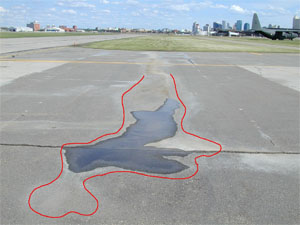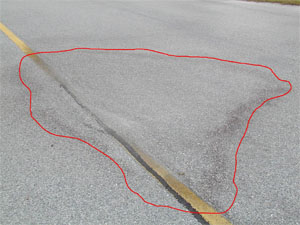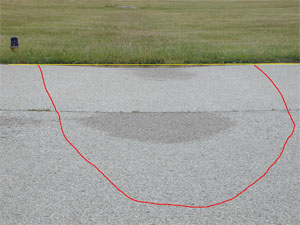- Indiana 2024 IDEA /
- Pavement Inspection /
- AC Distress Measurement /
- Depression
Depression
Depressions are localized pavement surface areas having elevations slightly lower than those of the surrounding pavement. In many instances, light depressions are not noticeable until after a rain, when ponding water creates "birdbath" areas. However, depressions can also be located without rain because of stains created by the ponding of water. Depressions can be caused by settlement of the foundation soil, or can be built during construction. Depressions cause roughness, and when filled with water of sufficient depth can cause hydroplaning of aircraft.
| Severity | Distress Example | Description |
|---|---|---|
| Low |  | Depression can be observed or located by water ponding or stained area due to ponding, only slightly affects pavement riding quality, and may cause hydroplaning potential on runways. Runways and High-Speed Taxiways: 1/8 to 1/2 in (3 to 13 mm) Taxiways and Aprons: 1/2 to 1 in (13 to 25 mm) |
| Medium |  | Depression can be observed or located by water ponding or stained area due to ponding, moderately affects pavement riding quality, and causes hydroplaning potential on runways. Runways and High-Speed Taxiways: 1/2 to 1 in (13 to 25 mm) Taxiways and Aprons: 1 to 2 in (25 to 51 mm) |
| High |  | The depression can be readily observed, severely affects pavement riding quality, and causes definite hydroplaning potential. Runways and High-Speed Taxiways: > 1 in (> 25 mm) Taxiways and Aprons: > 2 in (> 51 mm) |